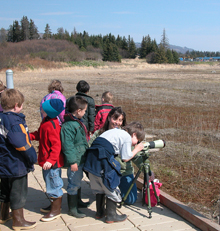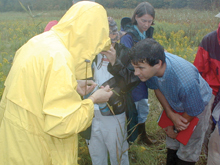NOAA's National Estuarine Research Reserve System Comes Alive
Through an array of carefully selected sites from around the country, the National Estuarine Research Reserve System helps preserve significant estuarine environments, while furthering the science of estuarine research and our understanding of how natural and human activities affect estuaries.
- Introduction
- The SW(a)MP Thing!
- Supporting Student Research
- Estuaries to the Classroom
- The Coastal Training Program
- Looking Ahead
- Works Consulted

High school students prepare for their state-wide "ENVIROTHON" by using data collected through the NERRS System-wide Monitoring Program. Click image for larger view and complete caption.
Throughout the 1960s, there was a great deal of discussion among resource managers and researchers about the need for protected areas in the many estuarine environments around the country. With the passage of the Coastal Zone Management Act of 1972, the National Estuarine Research Reserve System (NERRS) was created, and by the end of 1993, 21 reserves had been established in 17 states and Puerto Rico, covering nearly 600,000 acres of coastal and estuarine habitats. Between 1993 and 2006, six more reserves entered the system, bringing the network up to 27 reserves, more than doubling the total acreage.
In the early 1990s, the priority for NERRS shifted from expansion to a focus on using this new network as the basis for developing national programs to promote stewardship based on research and education. This article looks at the progression of various NERRS programs throughout this shift.
The SW(a)MP Thing!
In 1993, NERRS scientists "proposed a nationally coordinated monitoring program that would attempt to identify and track short-term variability and long-term changes in representative estuarine ecosystems and coastal watersheds." At the time, there was no such coordination of data and research amongst the various reserves.
What's Being Measured
The SWMP measures a range of parameters, including:
Water Quality:
pH
Conductivity (mS/cm)
Salinity (ppt)
Temperature (ºC)
Dissolved oxygen (%)
Turbidity (NTU)
Nitrate (mg/L)
Ammonia (mg/L)
Ortho-phosphate (mg/L)
Chlorophyll a (µg/L)
Weather:
Temperature (ºC)
Wind speed and direction (m/s; degrees)
Relative humidity (%)
Barometric pressure (mb)
Rainfall (mm)
Photosynthetic active radiation (mM/m2, total flux)
In 1995, their coordination efforts resulted in the establishment of the System-wide Monitoring Program (SWMP). All reserves participate in SWMP (affectionately pronounced “swamp”), which has been growing in planned phases since its inception.
Phase 1: Abiotic Factors
In the first phase, all the reserves installed at least two water quality data-loggers to measure temperature, dissolved oxygen, salinity, and a host of other parameters on both short- and long-term time scales. To manage the large volume of data (observations are collected every 15 minutes on 10 different water parameters), NOAA also established the Centralized Data Management Office (CDMO), which also provides training programs, technical assistance, and quality assurance and controls.
CDMO began publishing its collected water quality data on the Internet in 1998. In 1998 and 2000, reserve scientists produced two comprehensive syntheses of collected water quality data, explaining the relationships between variables such as salinity and tidal range, temperature and dissolved oxygen, and others. These findings have helped to form the base of knowledge for future research and for education and training programs. In 2001, the number of data-loggers at each reserve was increased to four, and scientists also began monitoring nutrients and chlorophyll in the water.

Elkhorn Slough NERR researcher working with a SWMP datalogger in the field. Click image for larger view.
In 2002, each reserve also installed a weather station and started collecting observations on basic weather data every 15 minutes. Weather and water quality data can now be correlated as well.
Phase 2: Biological Monitoring
The second phase of SWMP began in 2004, with the piloting of biological monitoring at several reserves. This monitoring focused on the variability and spatial distribution of aquatic vegetation over time. As this phase continues to develop, reserves will also monitor non-native (invasive) species and other biological variables, such as plankton communities, which make up estuarine ecosystems.
Phase 3: Land Use Classification
Phase three is currently in development and will focus on tracking and evaluating changes in NERRS habitats relative to changes in land use practices in the associated watershed.
Expanded Science
A key feature of the SWMP is that it supports the other missions of the reserve system. With SWMP in place, the ingredients exist to develop other national programs to connect the science of the reserves with the understanding and management of coastal ecosystems.
Supporting Graduate Student Research
The system's second national program began in 1997, with the establishment of the Graduate Research Fellows Program (GRF). One of just four NOAA fellowship opportunities for graduate students, the GRF program funds up to two graduate students per reserve each year with stipends of $20,000 per year. These students may conduct research at each of the 27 reserves in the system. Many of the students do their work on multi-year grants.
Including the 2006-2007 academic year, more than 180 graduate students have participated in the reserves' research and monitoring efforts, contributing significantly to the overall research effort. These students develop their research skills and knowledge as they become the next generation of coastal and estuarine scientists. Fellows have studied a wide range of topics in the reserves, including non-point-source pollution and habitat conservation and restoration. At least four former fellows are now working for NOAA or at one of the reserves.
The Internet Brings the Estuaries to the Classroom
Education, of course, begins long before graduate school. Indeed, long-term interests often start in grade school, and that is the target of the NERRS education efforts across the country.
One of the most popular education programs is EstuaryLive, or "E-Live." E-Live began as a local program at the North Carolina reserve in 1998, as a way to give tens of thousands of young students a "field trip" experience live over the Internet. Other reserves took note and, in September 2001, E-Live had its first national Webcast.

Reserves like Kachemak Bay National Estuarine Research Reserve in Alaska, are living classrooms for students. Education programs at the reserves provide field trip experiences backed by well-designed curricula to introduce the next generation of environmental scientists to coastal ecosystems. Click image for larger view.
The following year, NOAA began partnering with the U.S. Environmental Protection Agency's National Estuaries Program (NEP) to broadcast joint programs from research reserves and NEPs. The program uses state-of-the-art Webcasting equipment to transmit the events live to hundreds of classrooms around the country. To help teachers prepare for the events, NOAA publishes online curriculum guides and lesson plans in advance.
E-Live has now taken hundreds of thousands of K-12 students on Internet "field trips" to more than 20 estuaries on the Atlantic, Gulf of Mexico, and Pacific coasts. The programs, presented by reserve staff scientists and educators, as well as local teachers, students, and other experts, focus on engaging students in science. They rely on SWMP data and other research in the reserves to illustrate the natural processes being discussed. In one memorable program from Weeks Bay reserve in Alabama, shortly after Hurricane Ivan had passed through in 2004, staff showed thousands of students the graphic readouts from water data-loggers, illustrating the dramatic rise in water levels as Ivan's storm surge arrived.
The Coastal Training Program
While the reserve system's GRF and education programs are focused on developing future scientists and broader appreciation of coastal issues, another national program is aimed at helping today's coastal managers make the best possible decisions based on the best available science.

Coastal Training Program workshop participants learn to distinguish native and non-native phragmites at Great Bay NERR. Click image for larger view.
In 1998, the reserve system incorporated coastal management training workshops into basic reserve operations on a voluntary basis, providing $90,000 funding for participating reserves. These events were based on a series of workshops started at Rookery Bay reserve in Florida in 1988 and tested at 11 reserves starting in 1994. In 2002, the program became known as the Coastal Training Program (CTP).
Since 1994, more than 13,000 individuals have participated in CTP events sponsored by reserves. They have included land-use planners, elected officials, regulators, land developers, community groups, environmental non-profits, and coastal businesses. Training programs cover a wide range of topics, including habitat management and restoration, land use, invasive species, coastal hazards, regulatory issues, and ecotourism.
The foundation for the CTP is the research conducted at the reserves, which ensures that coastal managers can base decisions affecting natural and human coastal communities on accurate, up-to-date scientific observations.
Looking Ahead
Future NERRS endeavors envision continued development of programs grounded in scientific observations. Already, the SWMP is providing near real-time data for the burgeoning Integrated Ocean Observing System. Reserve managers and stewardship coordinators are using data to plan and design restoration projects, often in partnership with other federal and state agencies. And NERRS will continue to link students, teachers, and the general public with estuarine science. Through these efforts, we can increase our understanding and appreciation of estuaries, ensuring that they are protected well into the future.
Works Consulted
Ibanez, A., et al. (In press). EstuaryLive: Linking Classrooms to the Natural World. Proceedings of the Marine Technology Society Ocean 2005 Conference.
Owen, B and White, S. (2005). National Estuarine Research Reserve System 10th Anniversary Report on the System-wide Monitoring Program Data Applications, 1995-2005. National Oceanic and Atmospheric Administration.
